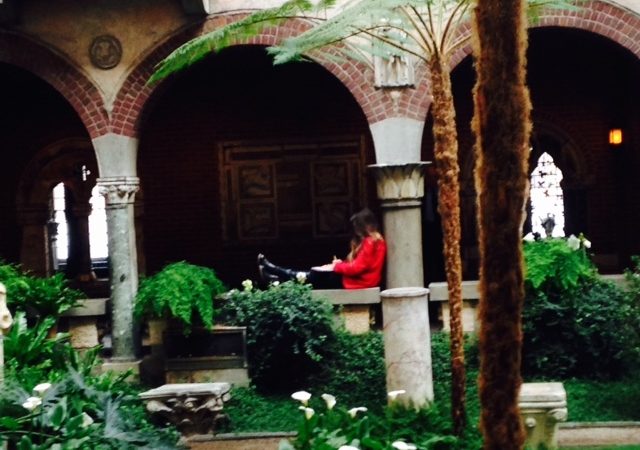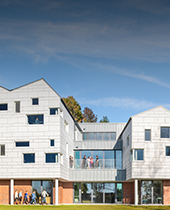Art History Goes to Boston
Nine students in this semester’s Masterworks of Art History class headed down for two days of field work with me in three major Boston Art Museums: The Isabella Stewart Gardner, the Museum of Fine Art, and the newly-opened Fogg Museum at Harvard University.
At the Isabella Stewart Gardner, students had two tasks to complete. First, and in groups, they were to find and record close commentary on eleven specific works, applying the analytical and viewing skills they have been honing all semester. Their second task was to spend 40 minutes alone with two pieces of art of their choice, responding to prompts designed to elicit very personal reactions to the art. For example: a. Find a work of art that, for you, embodies pure joy, or b. Find a work of art that speaks to Struggle.
The students headed off, excited to find art that they had only seen online; they needed no encouragement or guidance from me. I moved through the museum to see how they were progressing and was delighted to watch them, oblivious to the fact that I was acting as benevolent voyeuse, utterly engrossed in their work, batting ideas and insights back and forth as they discussed the art. After three-plus hours, all the students seemed to find themselves sitting around the Gardner’s exquisite central courtyard, breathing in the sweet smell of the seasonal flowers propagated in the Museum’s new greenhouses expressly for this space, and in accordance with Mrs. Gardner’s directive from ninety years ago.
On Friday evening, and after delicious Japanese food, the group gathered to watch Rebecca Dreyfus’s documentary, “Stolen,” re the theft of and now 25-year hunt to find fourteen priceless works of art stolen from the Gardner on March 18th, 1990. It was a wonderfully nerdy capstone to a spectacular day.
During their visits to the MFA and the Fogg, students were let lose to explore art on their own terms. Two hours in each site simply vanished as we all became totally absorbed by what we saw, making connections, finding new insights, and delighting in Renzo Piano’s spectacular architectural achievement at the Fogg Museum.
One of the defining qualities of this trip for the students and for me was having the luxury of dedicated time to spend with the art. A gracious benefactor provided us free overnight accommodation in Boston so that we did not have to cramp our visits into one day. We all deeply appreciated and relished such an opportunity for truly mindful learning.
Students reflected on their experience art in situ. Here are three reflections: from seniors Haley Johnson and Ellen Langford, veterans of Waynflete’s Art History electives, and from Ellis Heminway, a sophomore engaged in his first foray into this fascinating field.
Seeing art in the flesh is incredibly different than seeing the same piece behind a computer screen. Through a screen there is no context, only a web browser, nor is there any tangible sense of difference between one piece to another. Getting up close and personal with the art provided a sense of interaction, or story telling in each individual brushstroke.



